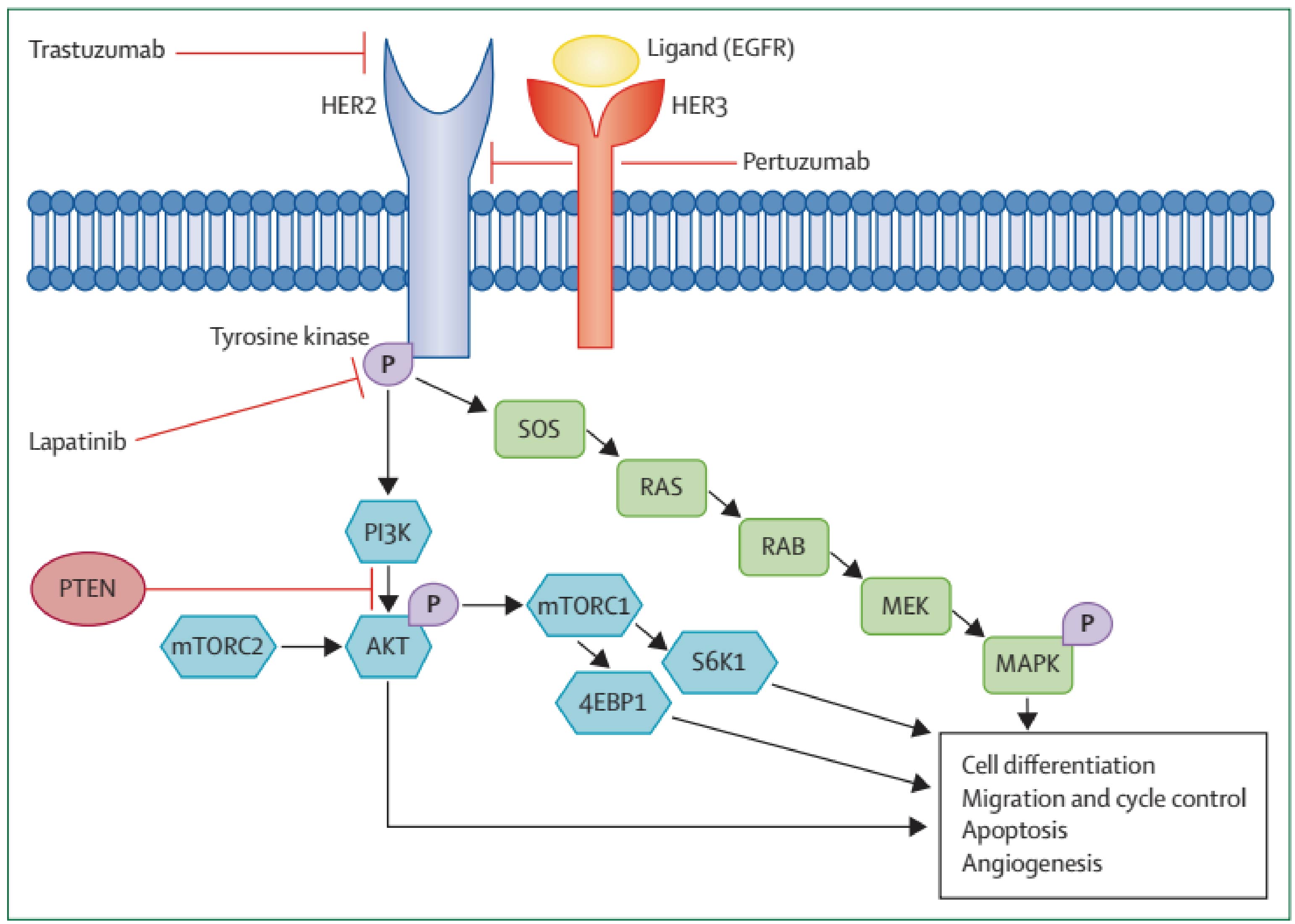
Our promise to you:
Guaranteed product quality, expert customer support.
 24x7 CUSTOMER SERVICE
24x7 CUSTOMER SERVICE
 CONTACT US TO ORDER
CONTACT US TO ORDER
ERBB2/HER2 Gene Editing 
The EGFR family consists of 4 members: ERBB1/EGFR, ERBB2 (HER2), ERBB3, and ERBB4. Transactivation of EGFR signaling is found in multiple cardiovascular (CV) conditions, including hypertension, heart failure, and cardiac and vascular hypertrophy. Research has demonstrated that EGFR is overexpressed in many cancer types being a crucial therapeutic cancer target. The ERBB2 gene was originally identified due to its oncogenic activity and its overexpression is associated with poor prognosis in cancer patients.
 Figure 1. EGFR signalling pathway and targeted therapies. (Loibl S, Gianni L. 2017)
Figure 1. EGFR signalling pathway and targeted therapies. (Loibl S, Gianni L. 2017)
ERBB2 Signaling In Cancer
Unlike ERBB4, ERBB2 is unable to bind ligands, but, it is the preferred heterodimerization partner for other ERBB receptors, stabilizing ligand binding, and enhancing and diversifying ligand-induced receptor signalling. Homo- or heterodimerization leads to the autophosphorylation of tyrosine residues within the cytoplasmic domain of the receptors and initiates various signaling pathways, principally the mitogen-activated protein kinase (MAPK), phosphatidylinositol-4,5-bisphosphate 3-kinase (PI3K), and protein kinase C (PKC) leading to cell survival, proliferation, differentiation, angiogenesis, and invasion.
In numerous different cancer cells, ERBB2 is amplified by increased gene transcription. Tumor growth is heavily dependent on ERBB2 amplification, a process coined oncogenic addiction of malignancy. Amplified ERBB2 can bind to ERBB3 in an uncontrolled and partially ligand-independent way, forming an oncogenic ERBB2/ERBB3 complex. In the ERBB2/ERBB3 complex, following phosphorylation of ERBB3 tyrosine residues by the ERBB2 kinase, ERBB3 interacts with the regulatory p85 subunit of PI3K without the requirement of any adaptor proteins. This leads to the robust activation of the PI3K/Akt pathway and intense cell growth and proliferation, positioning ERBB3 as the critical node in oncogenic ERBB2 signaling. ERBB2 has been suggested to be amplified in about 15% to 30% of breast cancers and 10% to 30% of gastric and esophageal cancers. Besides, amplifications in ERBB2 have been identified in ovarian, bladder, pancreatic, endometrial, and non–small cell lung cancers.
HER2-targeted Therapy for Breast Cancer
HER2 is overexpressed in 15-30% of invasive breast cancers, which has prognostic and predictive implications. Breast cancers can have up to 25-50 copies of the HER2 gene, and up to 40-100-fold increase in HER2 protein leading to 2 million receptors expressed at the tumor cell surface. A key element of the successful development of HER2-directed drugs has been the selection of candidates for treatment based on the level of HER2 positivity of the tumor. Since the development of trastuzumab, multiple drugs, antibodies, tyrosine kinase inhibitors, and antibody-drug conjugates have become available for the treatment of HER2-positive breast cancer. The success of neoadjuvant therapy in HER2-positive early breast cancer is especially acknowledged, since pertuzumab has been approved on the basis of a higher proportion of patients achieving a pathological complete response with pertuzumab and trastuzumab than with trastuzumab alone in a neoadjuvant study. Event-free survival after the confirmatory adjuvant trial completed recruitment was numerically better with pertuzumab plus trastuzumab than with trastuzumab alone. With survival rates of almost 5 years in women with metastatic HER2-positive breast cancer and 75% of patients achieving a pathological complete response, new treatments in the past decade have clearly improved the prognosis of HER2-positive breast cancer. Despite this progress, many patients still die of HER2-positive breast cancer, calling for the identification and investigation of newer and better therapies. One possibility involves testing combinations of the already available anti-HER2 agents, as well as combinations with mTOR-targeting agents, PI3K inhibitors, CDK4 and CDK6 inhibitors, or immunotherapies, which would increase the likelihood of developing effective treatments, particularly for metastatic breast cancer.
ERBB2 Gene Editing Service
CRISPR/Cas9 PlatformCB, one of the leading biotechnological companies specializing in gene editing, is dedicated to offering comprehensive CRISPR/Cas9 gene-editing services to a wide range of genomics researchers. Based on our platform, we can help you effectively ERBB2 gene deleted, inserted or point mutated in cells or animals by CRISPR/Cas9 technology.
- ERBB2 Gene Knockout: We offer ERBB2 gene knockout cell line and knockout animal model generation service with high quality. Typically, we develop CRISPR-mediated gene editing cell lines including HEK239T, Hela, HepG2, U87, but we can use other cell lines according to your requirements. Our one-stop KO animal model generation service that covers from sgRNA design and construct, pronuclear microinjection to Founders genotyping and breeding.
- ERBB2 Gene Knockin: CRISPR/Cas9 PlatformCB provides the one-stop ERBB2 knock-in cell line and knockout animal model generation services, including point mutation and gene insertion. Our expert staff has succeeded in dozens of ERBB2 knock-in cell line generation projects, including stem cells, tumor cells and even difficult-to-handle cells. We also have extensive experience in incorporating CRISPR/Cas9 technology into animal models, which have been fully recognized by our clients.
If you have any questions, please feel free to contact us.
Related Products at CRISPR/Cas9 PlatformCB
| CATALOG NO. | PRODUCT NAME | PRODUCT TYPE | INQUIRY |
| CDKM-0540 | B6J-Erbb2em1Cflox | Knockout Mouse | Inquiry |
| CLKO-0044 | ERBB2 KO Cell Lysate-HeLa | Knockout Cell Lysate | Inquiry |
| CSC-RT0539 | Human ERBB2 Knockout Cell Line-HeLa | Pre-Made Knockout Cell Line | Inquiry |
References
- Iqbal N, Iqbal N. Human epidermal growth factor receptor 2 (HER2) in cancers: overexpression and therapeutic implications. Molecular biology international, 2014, 2014.
- Vermeulen Z, et al. ErbB2 signaling at the crossing between heart failure and cancer. Basic research in cardiology, 2016, 111(6): 60.
- Tao Y, et al. Role of Erbin in ErbB2-dependent breast tumor growth. Proceedings of the National Academy of Sciences, 2014, 111(42): E4429-E4438.
- Patanè S. ERBB1/EGFR and ERBB2 (HER2/neu)—targeted therapies in cancer and cardiovascular system with cardiovascular drugs. International journal of cardiology, 2014, 176(3): 1301-1303.
- Loibl S, Gianni L. HER2-positive breast cancer. The Lancet, 2017, 389(10087): 2415-2429.